Since the discovery of dwarf planets in the solar system, Pluto has been degraded. At the same time, for scientists, it is like the discovery of a new world - "Pandora's box" has been opened. Scientists used to think that these dwarf planets were just a pile of boring rocks, and these celestial bodies were just some cold rock worlds without air, moving lifelessly in their own orbits.
However, as scientists study them more, they become more and more shocking and interesting. They are a world full of interesting geological phenomena and history. They can even tell us a lot about the solar system.
Scientists believe that there may be hundreds of dwarf planets in our solar system. So far, however, scientists have only identified six, five of which are Pluto with the moon Charon, the red Sedna, the bright and distant Aegean, ornithus, and the bean shaped pregnant God. They all travel in the Kuiper belt, which lies outside Neptune's orbit billions of miles from the sun. They are just the tip of the iceberg, and there may be many, many more dwarf planets waiting to be discovered.
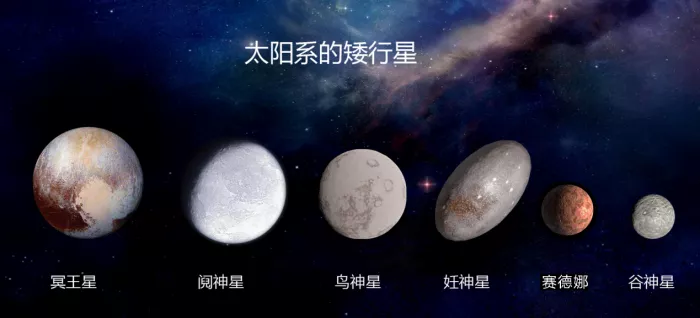
The sixth dwarf planet is Ceres, which runs inside the solar system. Its orbit is about 420million kilometers away from the earth, in the asteroid belt.
The asteroid belt is a region in the solar system between Mars and Jupiter. This is where most asteroids are located. These are the debris left by the formation of the solar system.
In the early days of the solar system, small rocks collided with each other, stuck together and formed rocky inner planets. Dwarf planets also formed in this way, when Ceres had become quite large. Before it stopped growing, it was becoming a planet. This makes it stand out from all the other asteroids there.
So why is Ceres called a dwarf planet instead of a planet?
To become a planet, it must have three cosmic elements. First, it must be a sphere; Second, it needs to orbit the sun rather than another celestial body; Third, it needs to remove other debris from the orbital area
Obviously, the valley God has only two elements. It is a sphere, but it is very small. It is only 965 kilometers wide, the size of Texas.
It revolves around the sun, but it has no ability to remove debris from its orbit. It is surrounded by asteroids.
So it cannot become a planet. Although we call these celestial bodies dwarf planets, dwarf planets are not insignificant.
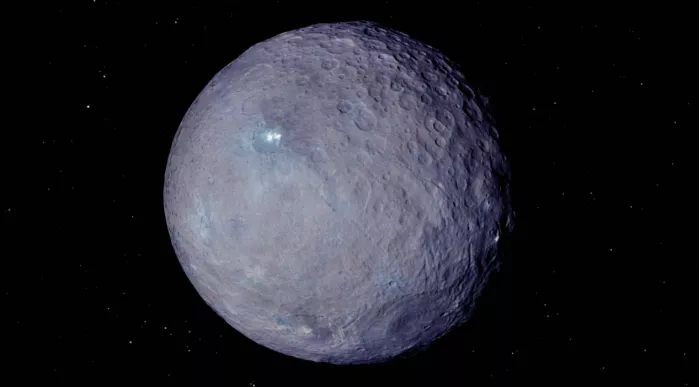
Ceres star
Scientists generally believe that dwarf planets are small, and the molten inner core will cool faster when it first forms. Therefore, the cores of dwarf planets should have been cooled, and the heat sources driving geological activities will also have been cooled.
So scientists think Ceres is basically just a huge rock, and nothing interesting will happen. When they really came into contact with Ceres, they found that their previous views were quite different from the truth.
In march2015, NASA's dawn probe arrived at Ceres. When the Dawn spacecraft arrived at Ceres, scientists saw the crater they expected to see on the surface.
Then suddenly, something completely mysterious came into their view. There are two bright spots in a crater on the surface of Ceres, almost like two eyes. These are the two bright spots in the large crater in the above picture.
These two highlights are very confusing to scientists because they don't know what is there?
It looks like ice. It seems very fresh. Then scientists discovered more than 100 such mysterious white spots. The largest one is located in the 80 kilometer wide OKAT impact crater.
What are they?
After analysis, the substance that makes up these white dots is a common substance on the earth: sodium carbonate, a salt.
Scientists believe that the salt on Ceres is very young. It is estimated that the youngest is only 4million years. Geologically speaking, this is basically the same as yesterday.
What is it that makes a long-term dead planet appear in pieces of salt?
Planetary geologist Gianni? Redber believes that these salts are similar to the crystalline salts in Mono Lake, California on earth.
At a certain time, many minerals were dissolved in part of the water of Mono Lake, and then as the lake surface subsided, the water evaporated, leaving these minerals as crystalline salts.

Large white sediments of Mono Lake, California crystalline salt
Researchers believe the same process happened on Ceres. This means that there must be liquid water under the surface of Ceres.
But how is this possible?
This is in the asteroid belt, a deep frozen world.
These bright spots are located in the center of the crater, and they are located around the cracks on the surface. This tells scientists that this material is coming up from below.
Absolutely no one expected liquid water beneath Ceres' surface. Scientists can't explain where the temperature that keeps the water comes from?
On some satellites, gravitational pull keeps the interior warm, such as io. But Ceres is not close to any other very large object. So it's amazing that scientists don't even know how this rocky planet works.
There may be another energy source, another mechanism for heating the interior, but we haven't found it yet.
In order to find out how Ceres had liquid water, we went back to the formation of the sun 4.6 billion years ago, leaving a lot of debris in the process. They collided together to form dwarf planets.
As they take shape, the heavier rock material sinks to the center, forming a hot molten core. Muddy water and ice floes float to the top and remain liquid for some time.
But once the core cools, it freezes and forms a solid shell.
It seems that we can't find the answer back in the past. So the emergence of salt is still a puzzling mystery, and still does not answer the question "how can there be liquid water on Ceres?"
Some scientists have suggested that the Aral Sea may exist under the surface of Ceres. It is not pure water, but a mixture of other things. The high concentration of salt lowers the freezing point of water and keeps it liquid.
When the asteroid impact ruptured the crust, salt water seeped from below, and then the liquid evaporated rapidly, but the salt still existed, leaving a bright white spot on the surface.
If this view is correct, it means that liquid water is now very close to Ceres' surface.
[Ceres is an "immigrant"]
With the in-depth study of Ceres, scientists found that Ceres is an "immigrant", that is, the asteroid belt is not the "birthplace" of Ceres. Ceres was probably born along with hundreds of other dwarf planets in the outer solar system.
Under normal circumstances, the material of celestial bodies should be the same as that of other nearby celestial bodies, but this is not the case with Ceres. The asteroid belt is mainly composed of dry rock bodies, which contain the heavy elements that make up the planets in the rocks.
Ceres is quite different. Ceres is essentially a world of ice, which is incompatible with the asteroids in the surrounding rocky world.
In addition, Ceres' ice also contains some compounds, but these compounds do not exist in the asteroid belt in the early solar system. For example, there is a large amount of ammonia on Ceres. Scientists cannot find ammonia near the inner solar system, but in the outer solar system, scientists do find ammonia. Ammonia has been found on Pluto, its moon Charon, and the frozen Kuiper belt.
So scientists believe that the source of ammonia should be in a very cold place in the solar system, even colder than the place where Ceres was discovered today.
However, an ice dwarf with ammonia is billions of miles away from the sun. How did Ceres come here?
Readers who have read the series of popular science articles written by the author should know that the orbits of planets have often drifted throughout the history of the solar system. Such as Jupiter, Uranus, Neptune and so on. So the same goes for dwarf planets.
More and more evidence shows that Ceres was formed at the outer edge of the solar system, and something brought this small world in. As for what it is, the answer is still Jupiter, the "bully" of the solar system.
After Jupiter's initial formation, the giant planet spiraled toward the sun. Its enormous gravity disturbs the orbits of other celestial bodies in the solar system, including Ceres.
The solar system is formed in a disk composed of gas and dust. When Jupiter is formed, it will pass through these substances. When it passes through these substances, it will be subject to resistance and kinetic energy will be reduced. Then the gravitational force of the sun overcomes the centrifugal force of Jupiter, and Jupiter will begin to move towards the sun relatively slowly.
Ceres was formed at the outer edge of the solar system. It broke away from the Kuiper belt and pulled inward due to the movement of Jupiter. When Jupiter stopped moving, Ceres also stopped moving, and then entered a new stable orbit on the asteroid belt.
Since Ceres is an "immigrant", has any other dwarf planet had a similar situation?
The answer is yes. Scientists believe that hundreds of dwarf planets composed of rocks and ice once roared into the solar system because of Jupiter.
But only one survived. If a group of dwarfs in the outer solar system migrated inward, Ceres might be the only survivor, the only one left.
So if Ceres settles down in its new home in the asteroid belt. Where are the other ice world dwarf planets? They may become part of the sun, or they may collide with other inner planets and melt into one or become each other's moons.
The theory that dwarf planets migrate from the outer solar system to the solar system has another evidence, which may be in our bodies.
For a long time, scientists have been wondering where most of the water on the earth comes from?
Because the earth is within the snow line of the solar system and close to the sun, there should be no water here. During the formation of the earth, water could not exist on the surface because it was too hot.
Then dwarf planets formed in the outer solar system, where water is abundant. During the journey of these dwarf planets, some of them crashed into the earth and poured water rich rocks towards the earth. There is enough water in these rocks to fill the earth's oceans.
And surprisingly, when scientists studied the chemical composition of water, they found that the water that can best match our bodies is water from asteroids.
Asteroids or dwarf planets have been falling and hitting the earth for billions of years. Even more surprising, dwarf planets may have brought something else.
In february2017, scientists announced the discovery of organic matter on the surface of Ceres.
On earth, the dwarf planet has both water and organic compounds that life needs. Both Pluto and Ceres have organic molecules, and liquid water exists under the earth's surface.
There is an energy source that can warm up the interior of the planet. It is not completely impossible for life to exist under these cold surfaces.
Scientists have found red patches on dwarf planets Sedna and ornithus, which come from an organic molecule called SOLIN. And they may be the origin of life.
Chemically, these dwarf planets are like test tubes in the solar system. If the solar system is full of such small bodies with liquid water or ice, they may become incubators of life. As long as life is attached to these small celestial bodies, it is ready to collide with another celestial body and sow seeds there.
This means that life may exist in the whole galaxy. Perhaps our existence should be thanks to the existence of dwarf planets
[Sedna may have been stolen by the sun]
The dwarf planet Sedna is a world more than 1600 kilometers wide, but its orbit in the solar system is very far away, and it is the farthest object discovered by scientists in the solar system.
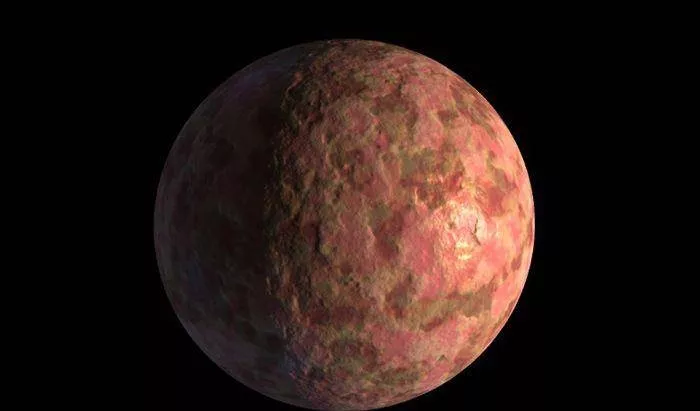
Dwarf planet Sedna
If you stand on the surface of Sedna and look back at the solar system, the sun will look like a very bright star, but not much brighter than a really bright star.
Like Pluto, Sedna has a strange elliptical orbit. Sedna's distance from the sun ranges from 11billion kilometers to 150billion miles.
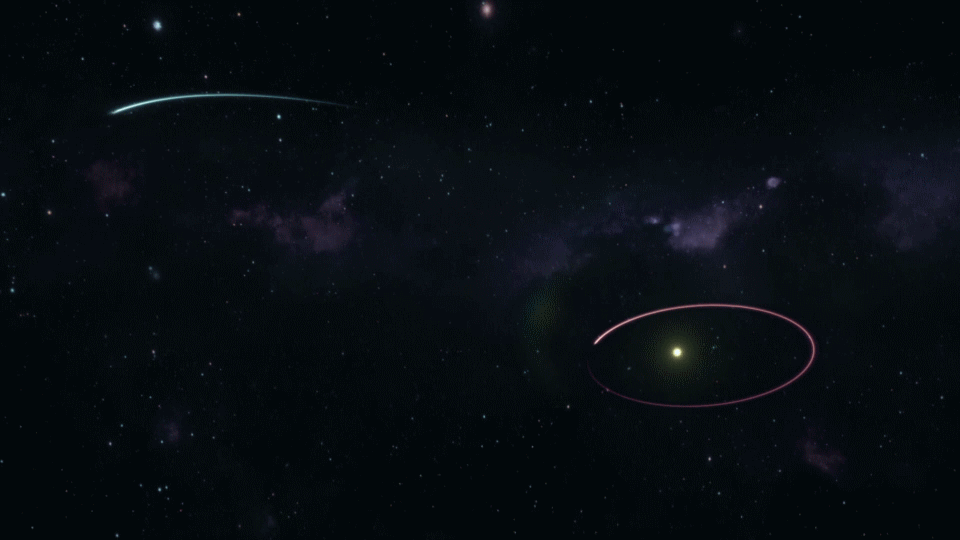
Sedna's elliptical orbit is the same as Pluto's elliptical orbit
The reason why Pluto has such an elliptical orbit is that close to Neptune, Neptune's gravity will affect its orbit and make it enter an elliptical orbit.
But the strange thing about Sedna is that its orbit is so far away from any major planet. How did it become an ellipse? Sedna will never be so close to Neptune. It is far from that orbit.
This means that Sedna cannot explain it with some theories we know. And for all the other celestial bodies in the solar system: the eight planets and many other, many small celestial bodies, scientists can explain why they were born or run there.
Sedna can't explain it with the theory of those celestial bodies, and when the computer is used to simulate changing the orbit of celestial bodies, it is almost impossible for Sedna to form in our solar system, and then change the orbit to make it oval and fly so far away from the sun
This means that it may not have been formed in the solar system, it may have come from a strange world.
So how does our solar system capture a celestial body from an alien world?
Let's go back to the time when the solar system was born. At that time, the sun was born in a stellar nursery, where there were many other baby stars.
So, if the sun is born in a very dense area, and many other stars are born in this area at the same time, then when these stars form planets, there will be material exchange between them
Sedna may have formed in a beautiful circular orbit like other objects around stars. Our sun passes through the main planet of the alien solar system. If that star is close enough to the sun, our gravity may steal Sedna out. It is likely that other dwarf planets have also been kidnapped from other galaxies
These alien stars carry water from the alien world, or even organic matter from the alien world, to the planets in the solar system.
If this theory is correct, then we, everyone on earth may have been "aliens".
In addition, there is another possible explanation, that is, the "ninth planet" that may be hidden in our solar system that the author mentioned when talking about the ice giants Uranus and Neptune.
This distant hidden ninth planet is thought to be very large, and its gravity can make Sedna's orbit oval. But scientists have not found the ninth planet yet.
Scientists believe that there may be many small objects like Sedna in our solar system. They are far away from us and scientists cannot detect them. Therefore, there may be hundreds of such objects. These new components of the solar system are still waiting for scientists to discover.
And these dwarf planets all over the solar system are revealing hidden life. Because scientists have discovered the elements of life on these dwarf planets. For example, Sorin organic molecules were found on Sedna, ornithus and Pluto, crystalline salt was found on Ceres, and the underground ocean was found on Pluto.
Scientists used to think that water could only exist in habitable zones. It is neither too hot nor too cold to cause the water to boil. The water will not freeze into solid. But now this view is obviously out.
We looked around and found water everywhere. We found water in the most unexpected places in the solar system. The discovery of liquid water very far from the sun shocked scientists.
In fact, in these distant worlds, there are constant surprises.
Uranus, 2/3 the size of Pluto, is covered with ethane and methane ice. Methane is frozen into ice particles 1/2 inch in size. It reacts with sunlight to form an organic molecule called SOLIN. These organic molecules give the planet a reddish brown color.
[bright and dazzling erishen star]
Farther away is Eris, which is about 14.5 billion kilometers away from the sun. Its surface temperature is about minus 240 degrees Celsius.
Eris is absolutely an attractive celestial body. Its surface looks almost completely bright. It can be said that Eris is one of the most dazzling celestial bodies in the solar system. It reflects 96% of the light.
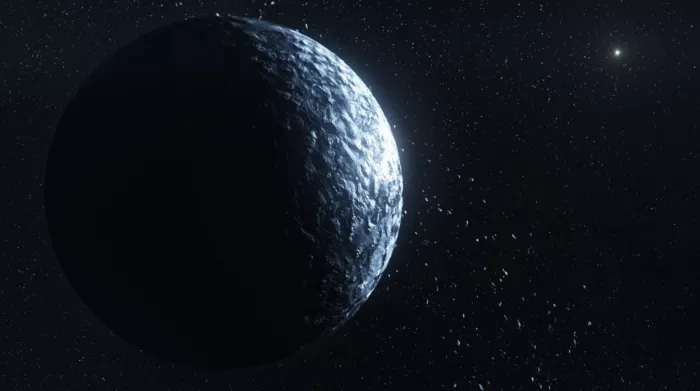
Bright and dazzling Eris star
Scientists want to know why. When new horizons visited Pluto, scientists found the answer.
When exploring Pluto on new horizons, we found an interesting little detail. Some things on Pluto look like sand dunes, which are completely composed of ice particles.
Then there must be wind to form "sand dunes". When the wind carrying sand blows through the valley, it leaves sand and deposits, and finally forms these huge and beautiful sand dunes.
Our planet is large enough to hold the atmosphere. When the air is heated by the sun, it will rise. Fresh air will be added from below, and wind will be generated.
Pluto is very small, far from the sun, and it is difficult to maintain its atmosphere. And new horizons did discover that Pluto has a thin atmosphere. But this atmosphere is temporary. Because Pluto's orbit is elliptical, sometimes it is far from the sun, sometimes it is close to the sun, and the weather will become warm. So Pluto has a winter and summer climate.
So Pluto's atmosphere depends on the season. In summer, it is warm enough. The extra heat evaporates some nitrogen ice on the surface, forming a thin atmosphere; In winter, the atmosphere freezes.
When there is an atmosphere, although Pluto's atmosphere is very thin, there is still wind, but as long as there is enough wind, small particles will begin to move, and the wind can take away these particles, thus forming "sand dunes".
Therefore, scientists believe that the surface of many dwarf planets may change significantly during their orbit around the sun.
This helps explain the bright surface of Eris, which is three times farther from the sun than Pluto. At this time, nitrogen on the surface of Eris will freeze on the surface. As Pluto enters winter, the gas will form ice, making the planet's surface highly reflective.
[the volcano on Ceres may disappear]
Looking at Ceres from a distance, the dwarf star looks even and dull. But from a close look, there is a huge feature in front of us. When scientists began to map the surface of Ceres, they saw one of the strangest objects, a volcano named ahuna Mons.
This is a strange, protruding mountain with very, very sharp sides. Compared with any other terrain on Ceres, it is very abrupt.
This is a mountain three miles high, and there is nothing like it on the entire surface of Ceres. It can be said that ahuna Mons dominates the landscape of Ceres.
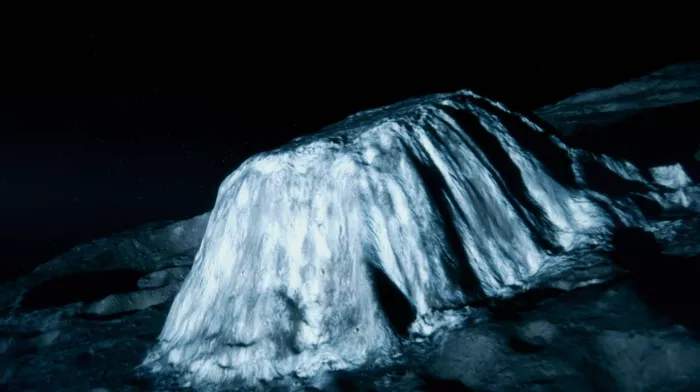
"Ahuna Mons" volcano on Ceres
Because of its steep side and huge height, it looks like a volcano on earth. But the volcanoes on the earth still have geological activities. Ceres is very small. Its core should have been frozen long ago.
In Iceland, the earth, there is a volcano whose shape is similar to that of ahuna Mons, that is helgarfi volcano.
This volcano is called rhyolite dome, which is a kind of lava. It is squeezed out through cracks in the ground surface, and then forms this bubble like dome. It is pushed higher and higher by the magma extruded from below. On the earth, when the hot magma bubbles slowly extrude from the surface cracks, a volcano with steep slopes will be formed.
But dwarf planets like Ceres are too small to have a hot lava core to support volcanic activity.
However, although there is no lava on these small planets, there is a lot of ice on them. And there is a lot of water under the surface. If water can flow upward through cracks and erupt on the surface, it will also get a "Volcano", which scientists call an ice volcano.
When the liquid water was squeezed up from the cracks on the surface, it quickly froze and then opened into this ice volcano. This ice volcano, you can see that it has very young characteristics, it has not been eroded.
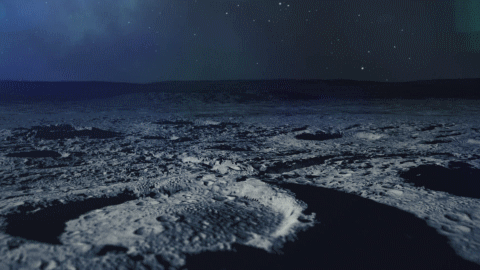
Formation of glacial volcanoes on Ceres
On earth, wind and water will slowly erode the helgarfi volcano. Ceres has no wind or other weather factors to erode the ice volcanoes, so once the ice volcanoes are formed, they will stay on the surface for billions of years
To scientists' surprise, Huna Mons iceberg is the only high mountain on Ceres.
Why?
Usually, there is not only one ice volcano, there should be many such volcanoes In fact, Ceres may have had many ice volcanoes, but today they are all gone. In other words, the only iceberg on Ceres may also disappear
The idea that volcanoes are disappearing sounds like science fiction, but in fact, it can happen under certain conditions.
The key to this "magic" is gravity, which can flatten solids. How fast depends on the structural composition of the material.
If you want to build a sand castle on the beach, you can't use dry sand. It won't stick together. So you have to mix some water in it so that when you build a sand castle, it will stick together. But if you add too much water, it will flow away, become a viscous fluid, and then it will collapse.
In fact, Iceland's rocky volcanoes will slowly collapse under their own pressure. Like the helgafi volcano in Iceland, it is also slowly collapsing, but at a very slow speed, which we cannot directly observe on the human time scale
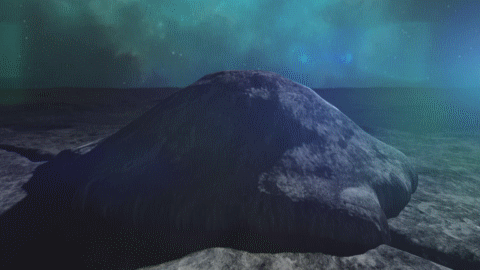
The disappearance of glacial volcanoes on Ceres
Ceres may have many ice volcanoes on its surface, but now they no longer show any signs of existence. So the ahuna Mons volcano will also slowly return to the surface of the planet.
[dwarf planets have many unsolved mysteries]
Why did Ceres no longer form ice volcanoes? This is still an unsolved mystery. In fact, this mystery is just one of many mysteries surrounding dwarf planets.
There are still many mysteries related to other dwarf planets to be solved by scientists, such as how dwarf planets got satellites.
Dwarf planets usually have orbiting satellites. Scientists have found that all the largest dwarf planets have satellites around them, and most of them have only one. There are two Gravidas and five Pluto.
Most dwarf planets have small moons that are not much larger than asteroids. But one of the moons is very different, that is, Charon, the moon of Pluto.
Pluto's moon can be said to be more strange than Pluto. The author once said in detail about Charon when talking about Pluto.
However, Charon has some problems that make scientists feel headache. As a satellite, Charon is too big compared with Pluto. It is better to say that "Pluto - Charon" is a double planet system than Charon is a satellite.
There are no other planets in the solar system whose moons are so large and so close to their host stars.
Like other binaries, Pluto and Charon orbit around a central gravitational point. Pluto and Charon are trapped in this gravitational dance, and they always look at each other.
The most interesting thing about Pluto and Charon is that they are in what we call tidal locking. When Pluto and Charon were formed, they may both rotate on their own axes, but the rotation of the two planets gradually slowed down and finally locked together. Always face each other with the same side during the revolution.
But Pluto's rotation is reversed, like a top spinning on its side. So Charon's orbit around Pluto is also reversed.
Almost every planet in the solar system has an orbital axis that points roughly in the same direction. Pluto is tilted about 120 degrees, and scientists have long wondered what caused the difference.
Did Charon pull Pluto over? Or is the tilt caused by the impact that formed Charon?
Through the observation of new horizons, scientists speculated that an object hit the top of Pluto, smashed the surface, and water seeped out and filled the crater. Liquid water makes Pluto out of balance, and the gravitational dance with Charon spins the heavy "heart" to the other side.
The Sputnik plain (that is, the "heart") was formed in situ because ice could accumulate at the bottom of a huge impact crater. But it is not sure whether this theory is true.
Once considered a small, lifeless dwarf planet, it is now full of mystery. They challenge all the assumptions of scientists.
However, scientists have only touched the surface of these complex worlds, and there are more dwarf planets to be discovered. Who knows what surprises they will bring?
Although scientists do not know the final number of dwarf planets, they believe that there may be 100 to 200 dwarf planets near Pluto. Further afield in the solar system, there may be more.
Dwarf planets are probably the most interesting objects we have found in our solar system. They are very diverse. They have active geology. They also contain liquid water.
Just because they're small doesn't mean they don't matter or should be ignored.
In the past, scientists could not even dream of their existence, but now these dwarf planets are like an open Pandora's box for scientists.
This is science!